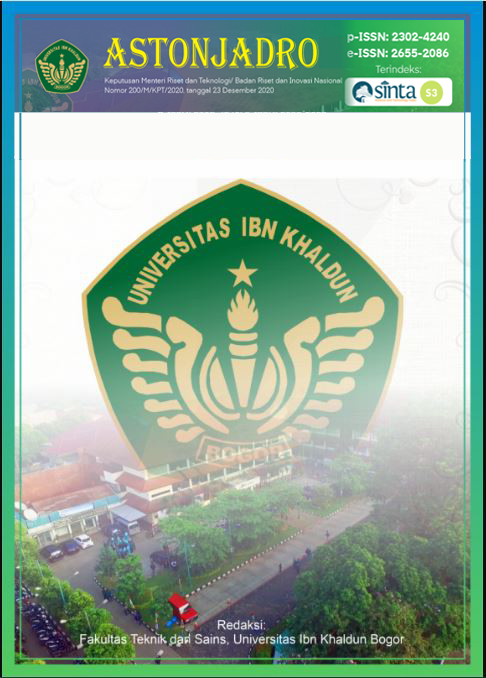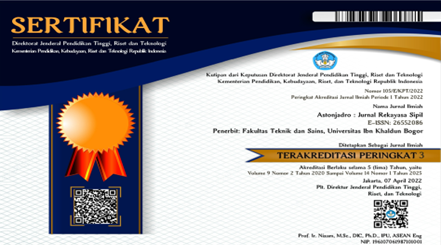Application of the Six Sigma Method in Railway Level Crossing Construction using Concrete Level Crossing in Gedebage-Haurpugur, West Java
DOI:
https://doi.org/10.32832/astonjadro.v14i1.17204Keywords:
Concrete Level Crossing (CLC); six sigma; CLC installation.Abstract
The public interest in trains makes train traffic increasingly dense, resulting in congestion at railroad and highway intersections. Intersections between railways and highways are divided into level and non-level crossings. The potential impact or risk of the existence of a level crossing can cause several problems, one of which is the wheels of vehicles (motorbikes) which often slip when crossing the tracks. To reduce the potential risk of the existence of level crossings in the form of vehicle tires slipping between the rail gaps, PT. In 2022, KAI develop solutions to the problems that occur, one of the methods is by adding a concrete product in the form of Concrete Level Crossing, which is a prestressed concrete plate made with a knock down system so that it can be easily dismantled and assembled in the field without having to disrupt train travel schedules. This research was conducted to determine the most important factors in improving the quality of CLC plate construction at railway level crossings, to determine the application of the Six Sigma method to CLC plates at railway level crossings, and to determine the effect of applying the Six Sigma method to plates. CLC for railway crossings. The independent variable (X) in this research is the Six Sigma method, while the dependent variable (Y) in this research is the implementation of railroad crossing construction using Six Sigma-based Concrete Level Crossing (CLC). The questionnaire survey was carried out via an online survey. The number of respondents who provided assessments on this research questionnaire was 33 respondents from 5 related companies. The respondents taken in this research consisted of 4 experts with the expert criteria being personal experience in the field of planning and operational implementation in Concrete Level Crossing (CLC) installation work. The most important variable in improving the quality of CLC installations is the Quality Control variable. Only the Quality Control variable has an influence on the implementation of Six Sigma in CLC installations. The results of the DPMO calculation show a defect value of 31,250 per million or the equivalent of 3.59 sigma, where the quality still needs to be improved to reach a value of 6 sigma.
References
Asfiati, et al. (2020). Studi Keselamatan dan Keamanan Transportasi di Perlintasan Sebidang Antara Jalan Rel dengan Jalan Umum. Progress in Civil Engineering Journal, Vol. 2. No. 1.
Aswad, Yusandy. (2013). Studi Kelayakan Perlintasan Sebidang antara Jalan Kereta Api dengan Jalan Raya . Jurnal MKTS Vol 19, No. 2, Universitas Sumatera Utara.
Ba˜nuelas, et al. (2005). An Application of Six sigma to Reduce Waste. Quality and Reliability Engineering International, Glasgow Caledonian University.
Gijo, et al. (2011). Application of Six sigma Methodology to Reduce Defects of a Grinding Process. Quality and Reliability Engineering International.
Hadiwisastra, Sapri. (2009). Kondisi Aspal Alam dalam Cekungan Buton . Jurnal Riset Geologi dan Pertambangan Jilid 19 No. 1, Pusat Penelitian Geoteknologi LIPI.
Han, et al. (2008). Six sigma-Based Approach to Improve Performance in Construction Operations. Journal of Management in Engineering.
Insiyah, Hisni. (2022). Aspek Hukum Perlintasan Kereta Api Ilegal di Wilayah Warungbambu Karawang. Jurnal Meta-Yuridis, Vol. 5, No.1.
Lestari et al. (2023). Studi Keselamatan dan Keamanan Transportasi pada Perlinrasa Sebidang Rel Kereta Api dengan Jalan Raya (Studi Kasus Perlintasan Kereta Api Cimindi, Kota Cimahi) . Majalah Ilmiah Teknik Sipil, Universitas Negeri Semarang.
Márquez, et al. (2017). New Methods for the Condition Monitoring of Level Crossings . University of Birmingham.
Mast, et al. (2012). An Analysis of The Six sigma DMAIC Method from The Perspective of Problem Solving. Int. J. Production Economics, University of Amsterdam.
Undang-Undang Republik Indonesia Nomor 38 Tahun 2004, Undang-undang tentang Jalan, Jakarta.
Undang-Undang Republik Indonesia, Nomor 23 Tahun 2007, Tentang Perkeretaapian, Jakarta.
Manual Bantalan Jalan Rel. 2015. PT. Wika Karya Beton. Biro Teknik. Jakarta.
Tripradipta, R., Priyanto, S., Fahmi Amrozi, M. R., & Kemp, A. H. (2024). Analysis of Integrated Railway QR Code Mobile Payment Systems’ Technology Acceptance. ASTONJADRO, 13(3), 708–721. https://doi.org/10.32832/astonjadro.v13i3.15571
Panjaitan, H., Priyanto, S., Dewanti, D., & Kemp, A. H. (2024). Internet of Things Implementation for Train Tracking Information (Case Study: UK and Indonesia). ASTONJADRO, 13(3), 732–746. https://doi.org/10.32832/astonjadro.v13i3.15646
Sugesti, B. G., Priyanto, S., Irawan, M. Z., & Whiteing, A. (2024). Encouraging the Shift of Modes of Freight Transport from Road to Railways in Indonesia (Case Study: Java Island). ASTONJADRO, 13(3), 779–790. https://doi.org/10.32832/astonjadro.v13i3.15684
Rahmawati, A., Dewanti, D., Parikesit, D., Timms, P., & Barnard, Y. (2024). Art and Transport: Background Music at The Train Stations in Java Island, Indonesia. ASTONJADRO, 13(3), 830–837. https://doi.org/10.32832/astonjadro.v13i3.15809
Downloads
Published
How to Cite
Issue
Section
License
Copyright (c) 2025 ASTONJADRO

This work is licensed under a Creative Commons Attribution-ShareAlike 4.0 International License.
Paper submitted to ASTONJADRO is the sole property of the Astonjadro Journal. Unless the author withdraws the paper because he does not want to be published in this journal. The publication rights are in the journal Astonjadro.ASTONJADRO
LICENSE
This work is licensed under a Creative Commons Attribution-ShareAlike 4.0 International License.
Based on a work at http://ejournal.uika-bogor.ac.id/index.php/ASTONJADRO













